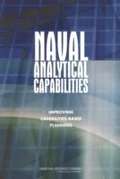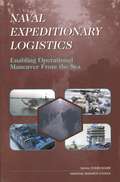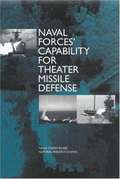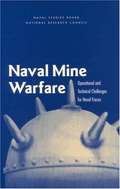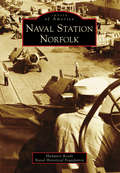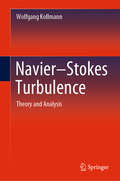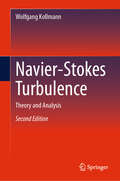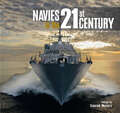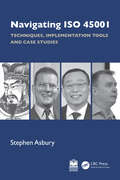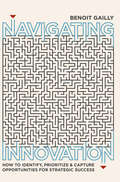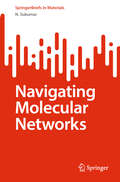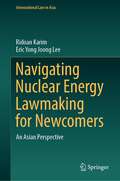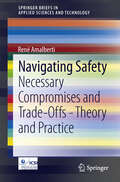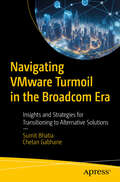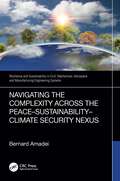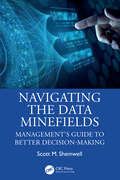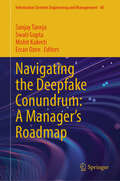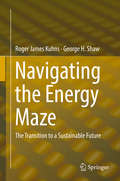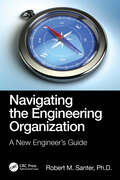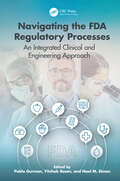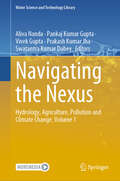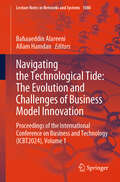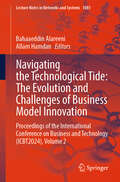- Table View
- List View
Naval Analytical Capabilities: Improving Capabilities-based Planning
by National Research Council of the National AcademiesThe National Academies Press (NAP)--publisher for the National Academies--publishes more than 200 books a year offering the most authoritative views, definitive information, and groundbreaking recommendations on a wide range of topics in science, engineering, and health. Our books are unique in that they are authored by the nation's leading experts in every scientific field.
Naval Expeditionary Logistics: Enabling Operational Maneuver From the Sea
by National Research CouncilInformation on Naval Expeditionary Logistics
Naval Forces' Capability For Theater Missile Defense
by Institute of Medicien National Academy of Science National Academy of EnegineeringA report on the Naval Forces' Capability For Theater Missile Defense
Naval Forces' Defense Capabilities Against Chemical and Biological Warfare Threats
by Committee for an Assessment of Naval Forces' Defense Capabilities Against Chemical Biological Warfare ThreatsThis book reviews a draft report from the federal government that assesses the effects of oxygenated gasoline on public health, air quality, fuel economy, engine performance, and water quality. In addition to evaluating the scientific basis of the report, the book identifies research needed to better understand the impacts of oxygenated fuels. Methyl tertiary-butyl ether (MTBE), which is intended to reduce carbon monoxide pollution during winter, is the most commonly used additive in the federal oxygenated fuels program. MTBE has been implicated in complaints by the public of headaches, coughs, and nausea. Other questions have been raised about reduced fuel economy and engine performance and pollution of ground water due to the use of MTBE in gasoline. The book provides conclusions and recommendations about each major topic addressed in the government's report.
Naval Mine Warfare: Operational and Technical Challenges for Naval Forces
by Committee for Mine Warfare AssessmentA report on the Operational and Technical Challenges for Naval Forces
Naval Station Norfolk (Images of America)
by Hampton Roads Naval Historical FoundationNaval Station Norfolk is the world's largest naval station, supporting the Navy ships, submarines, and aircraft of the US Fleet Forces Command with a multitude of facilities and services. This shore establishment, located on the historic harbor of Hampton Roads, has remained vital to the Navy since its foundation in 1917. Once established, the naval station focused on serving the fleet in four areas: aviation, recruit training, a submarine base, and a supply base. Men and women of the station continued to work on these and other activities through the pressures of World War I, the Depression, World War II, and wars in Korea, Vietnam, Iraq, and Afghanistan. They made sure that ships and aircraft were successfully deployed to the far reaches of the globe--the nation's indispensable response to international conflicts. Nowadays, the station is the hub for Navy logistics supporting the defense of the entire Atlantic area, from the North Pole to the South Pole.
Navier-Stokes Turbulence: Theory and Analysis
by Wolfgang KollmannThe book serves as a core text for graduate courses in advanced fluid mechanics and applied science. It consists of two parts. The first provides an introduction and general theory of fully developed turbulence, where treatment of turbulence is based on the linear functional equation derived by E. Hopf governing the characteristic functional that determines the statistical properties of a turbulent flow. In this section, Professor Kollmann explains how the theory is built on divergence free Schauder bases for the phase space of the turbulent flow and the space of argument vector fields for the characteristic functional. Subsequent chapters are devoted to mapping methods, homogeneous turbulence based upon the hypotheses of Kolmogorov and Onsager, intermittency, structural features of turbulent shear flows and their recognition.
Navier-Stokes Turbulence: Theory and Analysis
by Wolfgang KollmannThis updated/augmented second edition retains it class-tested content and pedagogy as a core text for graduate courses in advanced fluid mechanics and applied science. The new edition adds revised sections, clarification, problems, and chapter extensions including a rewritten section on Schauder bases for turbulent pipe flow, coverage of Cantwell’s mixing length closure for turbulent pipe flow, and a section on the variational Hessian. Consisting of two parts, the first provides an introduction and general theory of fully developed turbulence, where treatment of turbulence is based on the linear functional equation derived by E. Hopf governing the characteristic functional that determines the statistical properties of a turbulent flow. In this section, Professor Kollmann explains how the theory is built on divergence free Schauder bases for the phase space of the turbulent flow and the space of argument vector fields for the characteristic functional. The second segment, presented over subsequent chapters, is devoted to mapping methods, homogeneous turbulence based upon the hypotheses of Kolmogorov and Onsager, intermittency, structural features of turbulent shear flows and their recognition.
Navier-Stokes-Fourier Equations
by Radyadour Kh. ZeytounianThis research monograph deals with a modeling theory of the system of Navier-Stokes-Fourier equations for a Newtonian fluid governing a compressible viscous and heat conducting flows. The main objective is threefold. First , to 'deconstruct' this Navier-Stokes-Fourier system in order to unify the puzzle of the various partial simplified approximate models used in Newtonian Classical Fluid Dynamics and this, first facet, have obviously a challenging approach and a very important pedagogic impact on the university education. The second facet of the main objective is to outline a rational consistent asymptotic/mathematical theory of the of fluid flows modeling on the basis of a typical Navier-Stokes-Fourier initial and boundary value problem. The third facet is devoted to an illustration of our rational asymptotic/mathematical modeling theory for various technological and geophysical stiff problems from: aerodynamics, thermal and thermocapillary convections and also meteofluid dynamics.
Navies in the 21st Century
by Conrad Waters&“A range of naval experts . . . build[s] a diverse and deeply-thought out picture of where maritime warfare is now and where it is likely to go.&”—Army Rumour Service What is the purpose of navies in the modern world, and what types of warship does this require? This book tackles these questions by looking at naval developments, both technological and operational, in the quarter century since the end of the Cold War. It provides the overall political and economic context, assesses significant naval operations from the first Gulf War to Russia&’s annexation of Crimea, reviews changes in the objectives and composition of the principal fleets, describes major design developments amongst the main warship types, and examines wider technological and operational developments, including naval aviation, shipbuilding and manning. &“A high quality publication with a great many superb photographs. For those wishing to keep fully informed on world naval affairs, it is excellent value and strongly recommended.&”—Scuttlebutt &“This new book follows the successful approach and format of the very popular naval annual Seaforth&’s World Naval Review. Under the same editor, a new team of specialists have been assembled to write authoritative articles in their particular fields of expertise. The absorbing text is fully supported by many outstanding images—Most Recommended.&”—Firetrench &“Provides a most useful contextual analysis of the post-Cold War period, explaining how technological developments and a range of world events have variously shaped the fleets of today.&”—Warship
Navigating ISO 45001: Techniques, Implementation Tools and Case Studies
by Stephen AsburyThere has been a 2,500-year evolution in structured means of control and management systems. Occupational health and safety management systems are an essential tool for initiating and driving cultural change, and for establishing a framework for continual improvement in safety performance. Navigating ISO 45001 charts this evolution up to the launch of the world’s first occupational health and safety management system (OH&S-MS) standard ISO 45001:2018, and then forecasts its future for the next ten years.This book delivers approaches and techniques that include the Navigating 45001: Three-Step Model, sixteen OH&S-MS implementation Toolkits, and 24 case studies presented as practical examples to facilitate your organization’s success in this critical business area. Acting as the essential companion to Health and Safety, Environment, and Quality Audits: A Risk-based Approach (Asbury, 2023) which is now in its fourth edition and has sold thousands of copies, this new book presents OH&S-MS from the organization’s side. Written with the safety manager in mind, it will become the "go-to" title for those who aspire to drive a prosperous and thriving organization based on world-class OH&S management and performance.Navigating ISO 45001 is an essential reading for senior managers and safety managers in any safety-critical role or profession.Downloadable and copyright-free documents, videos, and useful URL links are provided on the book’s companion website.
Navigating Innovation: How To Identify, Prioritize And Capture Opportunities For Strategic Success
by Benoit GaillyEvery firm must maintain an entrepreneurial ecosystem and a coherent innovation strategy in order to stay ahead of the competition. For managers this means being able to build a vision of what innovation looks like in the context of their organization, fostering entrepreneurial behaviour, spotting opportunities and making the right decisions. Based on years of practical experience and unique insight, this handy guide identifies fundamental challenges and is rooted in concrete examples. Accompanied by a brand new app for iPhone and Android as well as a companion website (www.NavigatingInnovation.org), this is an easy dip in, dip out guide with a focus on successful execution. Navigating Innovation is a one-stop-shop, giving you a deeper understanding of the core concepts and tools to capture the right opportunities for your business.
Navigating Molecular Networks (SpringerBriefs in Materials)
by N. SukumarThis book delves into the foundational principles governing the treatment of molecular networks and "chemical space"—the comprehensive domain encompassing all physically achievable molecules—from the perspectives of vector space, graph theory, and data science. It explores similarity kernels, network measures, spectral graph theory, and random matrix theory, weaving intriguing connections between these diverse subjects. Notably, it emphasizes the visualization of molecular networks. The exploration continues by delving into contemporary generative deep learning models, increasingly pivotal in the pursuit of new materials possessing specific properties, showcasing some of the most compelling advancements in this field. Concluding with a discussion on the meanings of discovery, creativity, and the role of artificial intelligence (AI) therein.Its primary audience comprises senior undergraduate and graduate students specializing in physics, chemistry, and materials science. Additionally, it caters to those interested in the potential transformation of material discovery through computational, network, AI, and machine learning (ML) methodologies.
Navigating Nuclear Energy Lawmaking for Newcomers: An Asian Perspective (International Law in Asia)
by Eric Yong Lee Ridoan KarimThis book provides a comprehensive overview of the legal and regulatory framework for the nuclear industry from an Asian perspective. It includes information on the history of nuclear lawmaking, the key international treaties and agreements that govern the use of nuclear energy, the role of national and regional regulatory bodies, and the legal and policy issues that arise in the development and operation of nuclear power plants. The book also covers topics such as nuclear safety, security, waste management, environmental protection, and liability for nuclear accidents. Additionally, it provides insights into the legislative process and the various stakeholders involved in nuclear lawmaking, such as industry, government, and civil society organizations. The overall goal of this book is to provide a detailed and up-to-date understanding of the legal and regulatory framework for the nuclear newcomers, particularly in Asia, and to help readers navigate this complex and dynamic field.The book is also used as a guide for all nuclear energy-producing countries, lawmakers, students, researchers, or even for general readers to understand the perspectives of international nuclear energy law.
Navigating Safety
by René AmalbertiManaging safety in a professional environment requires constant negotiation with other competitive dimensions of risk management (finances, market and political drivers, manpower and social crisis). This is obvious, although generally not said in safety manuals. The book provides a unique vision of how to best find these compromises, starting with lessons learnt from natural risk management by individuals, then applying them to the craftsman industry, complex industrial systems (civil aviation, nuclear energy) and public services (like transportation and medicine). It offers a unique, illustrated, easy to read and scientifically based set of original concepts and pragmatic methods to revisit safety management and adopt a successful system vision. As such, and with illustrations coming from many various fields (aviation, fishing, nuclear, oil, medicine), it potentially covers a broad readership.
Navigating VMware Turmoil in the Broadcom Era: Insights and Strategies for Transitioning to Alternative Solutions
by Sumit Bhatia Chetan GabhaneFor the past two decades, VMware has dominated the infrastructure virtualization space, with organizations relying heavily on its ESXi platform for virtualizing their environments. However, the recent takeover of VMware by Broadcom has brought unprecedented changes that have unsettled the industry. These changes include the end of perpetual licenses, alterations to the licensing model requiring a minimum purchase of 16 cores, termination of existing contracts, and a significant increase in licensing costs. Such developments have posed challenges for numerous organizations worldwide. As cloud modernization gains momentum, organizations are gradually reducing their dependence on on-premises infrastructure. While cloud adoption is on the rise, certain factors such as compliance, security, and legal restrictions necessitate the retention of specific resources on-premises. Despite the growing cloud trend, VMware remains the preferred choice for many specialists due to its longstanding presence. However, Broadcom&’s actions to exploit this niche hosting requirement by significantly raising product costs have left many organizations feeling betrayed and actively seeking alternatives. This book provides objective insights to help organizations break free from vendor lock-in and navigate the changing landscape. It delves into the ruthless changes introduced by Broadcom to VMware and discusses the challenges of transitioning to alternatives. By offering a practical understanding of various available options, including emerging virtualization technologies, the book empowers industry experts to manage their existing dependence on VMware effectively. Real-world case studies and examples further reinforce the argument for adopting diverse VMware alternatives tailored to the unique settings of each organization. What You Will Learn Review the unprecedented changes brought about by Broadcom&’s takeover of VMware, including the termination of perpetual licenses, alterations to licensing models, and substantial increases in licensing costs. Understand the evolving landscape of virtualization technology and the challenges organizations face in transitioning away from VMware. Study the practical strategies and emerging virtualization technologies available as alternatives to VMware. Who This Book Is For IT architects, Admins, Technical Managers, CTOs, and Infrastructure solution experts.
Navigating the Complexity Across the Peace–Sustainability–Climate Security Nexus (Resilience and Sustainability in Civil, Mechanical, Aerospace and Manufacturing Engineering Systems)
by Bernard AmadeiPromoting peace and sustainability in human development while accounting for the risks associated with the impact of climate change on society has become more imperative than ever when addressing humanity's challenges of the twenty-first century. There is enough evidence that peace, sustainability, and climate security are entangled with multiple complex interactions and cannot be dealt with in isolation and independently from the environment and the numerous systems with which they interact. Yet, the intersection of peace, sustainability, and climate security or their opposites (i.e., conflict, unsustainability, and climate vulnerability) is rarely articulated with a systemic mindset. A multi-solving nexus approach is more appropriate to capture the complexity and uncertainty of how the three sectors of peace, sustainability, and climate security play a role in community development, the nature of their causal chains, and the feedback on how community development affects the three sectors. Navigating the Complexity Across the Peace–Sustainability–Climate Security Nexus explores the value proposition of using a systems approach, methodology, and tools to comprehend and model that dynamic. Features of the book: Explores the interaction between the different components of peace and the relationship between peace, sustainability, and climate security using semi-qualitative and quantitative tools; Explains how climate adaptation and mitigation are related to peace or conflict; Presents generic system dynamics modeling that can be used in different contexts.
Navigating the Data Minefields: Management's Guide to Better Decision-Making
by Scott M. ShemwellVolumes have been written on the need for high-quality data to support organizational decision-making. Most of those books appear to focus on the development and sustainment of data from the standpoint of those directly responsible for the management of data stores and the use of technology necessary to acquire, store, and secure data sets.Navigating the Data Minefields: Management’s Guide to Better Decision-Making provides executives and subject matter experts (SMEs) with a "reasonable" set of useful tools they can adapt to their specific organization and operating environment. While complexity can never be taken out of an integrated system, decision-making can be facilitated by using metrics that take into consideration the quality of the data used to make decisions, i.e., risk mitigation.Professionals who depend on large high-quality data sets, such as senior and mid-level management, engineering SMEs, data scientists, IT, systems engineers, and medical professionals, will want to have this book in their decision-making arsenal.
Navigating the Deepfake Conundrum: A Manager's Roadmap (Information Systems Engineering and Management #44)
by Swati Gupta Mohit Kukreti Ercan Ozen Sanjay TanejaThis book provides a structured roadmap for managers, researchers, and policymakers to navigate the evolving landscape, offering insights into brand perception, financial decision-making, corporate transparency, and governance. Deepfake technology is reshaping industries, raising critical ethical, managerial, and regulatory challenges. Bringing together interdisciplinary research, it blends statistical analysis, structural equation modeling, and bibliometric approaches to explore real-world applications and mitigation strategies. With case studies spanning hospitality, sports, education, and SMEs, the book equips professionals with tools to detect, manage, and ethically engage with deepfake advancements. An essential resource for academics, business leaders, and policymakers, it fosters informed decision-making in an era of digital deception.
Navigating the Energy Maze
by George H. Shaw Roger James KuhnsThis book presents essential information for the development of a comprehensive sustainable energy policy. It examines the diverse types of energy, their resource abundance and the material needs to develop and use them, and how communities and cities can better control their own destinies by locally managing energy use and generation. This approach does not suggest the undoing of existing infrastructures and energy providers, but rather a cooperative transition from national-regional energy management to a more local-centered system. The information is the foundation for eight specific legislative initiatives necessary for a national comprehensive sustainable policy that can both facilitate and drive the process of evolution from a carbon-energy economy to a sustainable renewable energy future.
Navigating the Engineering Organization: A New Engineer's Guide
by Robert M. SanterTransitioning new engineers into professionals who can blend in and contribute to the technical organization is, at best, doubtful. Trained in the "nuts and bolts" of a technical subject, new engineers have little to no training on the "soft" skills of how to work within an organization. This robust guide shows new engineers how to quickly operate and succeed within their new engineering organization.Navigating the Engineering Organization: A New Engineer’s Guidefocuses on the group behaviors of technical organizations. It provides a rigorous organizational framework to operate from and delivers guidance using a dual approach of academic insight and professional experience. Through numerous case studies, the book presents actual experiential guidance and offers a method on how to extend the insights covered in the book and turn them into a valuable personal model, valid throughout the engineer’s career. It helps readers understand quickly the unique values and expectations within their new engineering organization and guides them in discovering the proper ways to respond to these expectations. They can then act on these insights to deliver successful results, now and throughout their careers.The approach and goals found in this book provide a building block to help all new engineers cross the "Great Divide" from student to professional and succeed in their new engineering organization.
Navigating the FDA Regulatory Processes: An Integrated Clinical and Engineering Approach
by Pablo Gurman, Yitzhak Rosen, and Noel M. ElmanThis book provides a unique knowledge source of the FDA’s regulatory processes to anyone interested in the development and approval of biomedical products.Navigating the FDA Regulatory Processes will be of particular importance for those innovating in biomedical devices, pharmacological therapies, and combination products, who are interested in considering regulatory affairs early on in product development. The authors offer a comprehensive exploration of FDA regulations, providing industry insights and guidance for navigating the complexities of drug and device development. The book offers concrete examples, industry perspectives, and historical context, ensuring clarity and aiding in successful understanding of the requirements for regulatory compliance. Readers will also gain a thorough understanding of FDA regulatory processes, from securing approvals to navigating expedited pathways. Lastly, the book provides unique insights into the FDA approach for emergency preparedness, including discussing the recent COVID-19 pandemic.Biomedical industry personnel, engineers, scientists, entrepreneurs, medical doctors, students, and anyone interested in the development and approval of medical products in the US will find this book useful and essential.
Navigating the Nexus: Hydrology, Agriculture, Pollution and Climate Change, Volume 1 (Water Science and Technology Library #102)
by Pankaj Kumar Gupta Swatantra Kumar Dubey Prakash Kumar Jha Aliva Nanda Vivek GuptaThis book encompasses updated information as well as future directions for researchers working in the fields of environmental science, water resource engineering, and agricultural science. Navigating the Nexus: Hydrology, Agriculture, Pollution, and Climate Change focuses on the thematic areas of water resource, agriculture, and environmental domains. This book covers advances in modelling approaches, including Machine Learning (ML)/Artificial Intelligence (AI) applications; GIS and remote sensing; and sensors; to provide hydrological, agricultural, and environmental solutions during the ongoing climate crisis.
Navigating the Technological Tide: Proceedings of the International Conference on Business and Technology (ICBT2024), Volume 1 (Lecture Notes in Networks and Systems #1080)
by Allam Hamdan Bahaaeddin AlareeniIn an era defined by technological breakthroughs such as AI, blockchain, and IoT, this book offers a fresh and practical approach to Business Model Innovation (BMI). It delves into how technological advancements drive new business models and enhance operational efficiency, providing actionable insights and real-world examples for business leaders, strategists, operations managers, entrepreneurs, and students in business and technology disciplines. Encouraging diverse research methods, including theoretical, empirical, and multimethod studies, it welcomes manuscripts with clear managerial or policy implications. Aimed at students, scholars, researchers, professionals, executives, government agencies, and policymakers, this book equips readers with tools to succeed in today's dynamic business environment and supports multidisciplinary research to advance innovation management practices.
Navigating the Technological Tide: Proceedings of the International Conference on Business and Technology (ICBT2024), Volume 2 (Lecture Notes in Networks and Systems #1081)
by Allam Hamdan Bahaaeddin AlareeniIn an era defined by technological breakthroughs such as AI, blockchain, and IoT, this book offers a fresh and practical approach to Business Model Innovation (BMI). It delves into how technological advancements drive new business models and enhance operational efficiency, providing actionable insights and real-world examples for business leaders, strategists, operations managers, entrepreneurs, and students in business and technology disciplines. Encouraging diverse research methods, including theoretical, empirical, and multimethod studies, it welcomes manuscripts with clear managerial or policy implications. Aimed at students, scholars, researchers, professionals, executives, government agencies, and policymakers, this book equips readers with tools to succeed in today's dynamic business environment and supports multidisciplinary research to advance innovation management practices.
